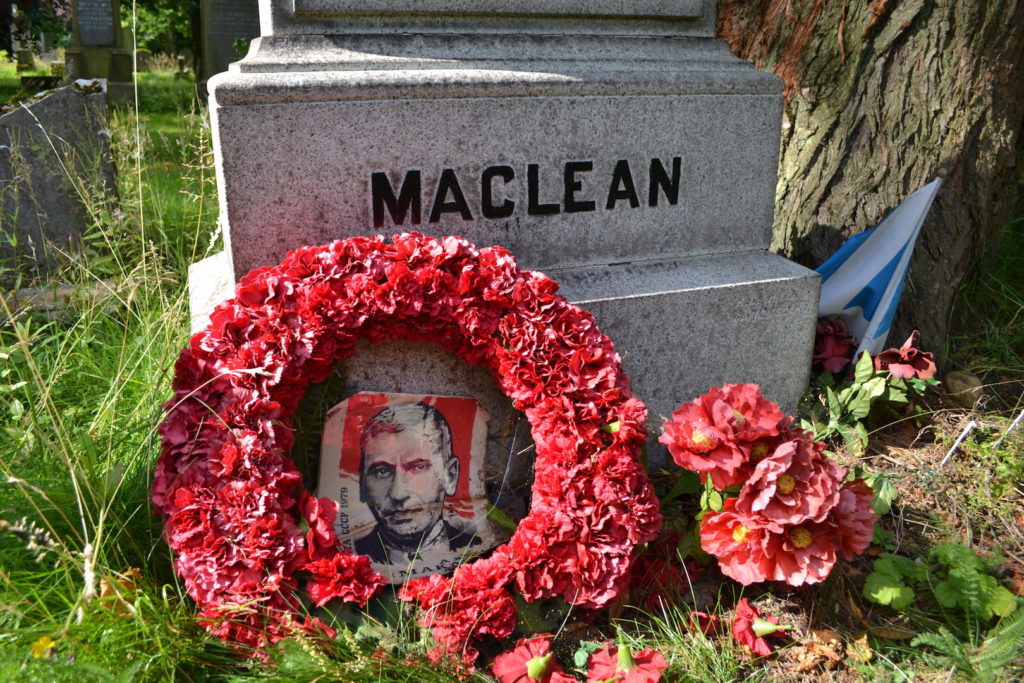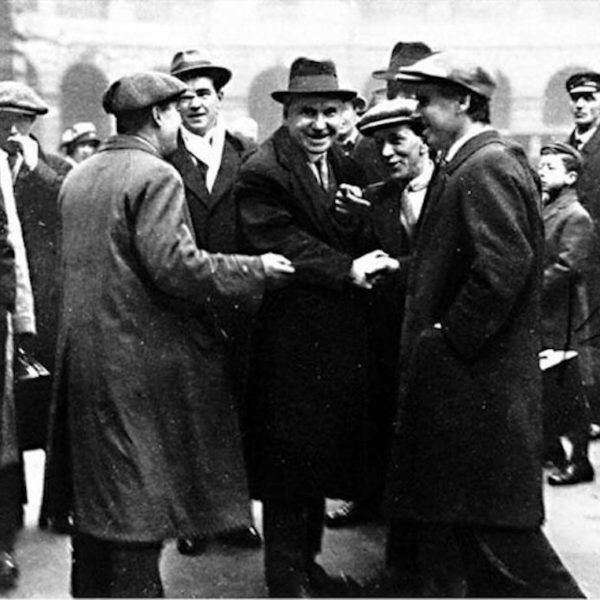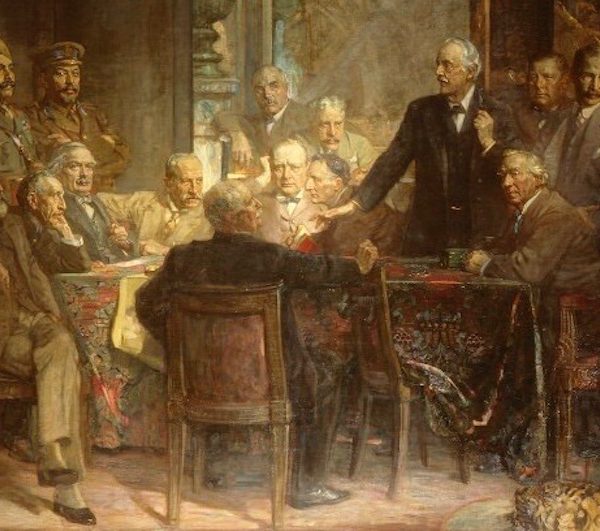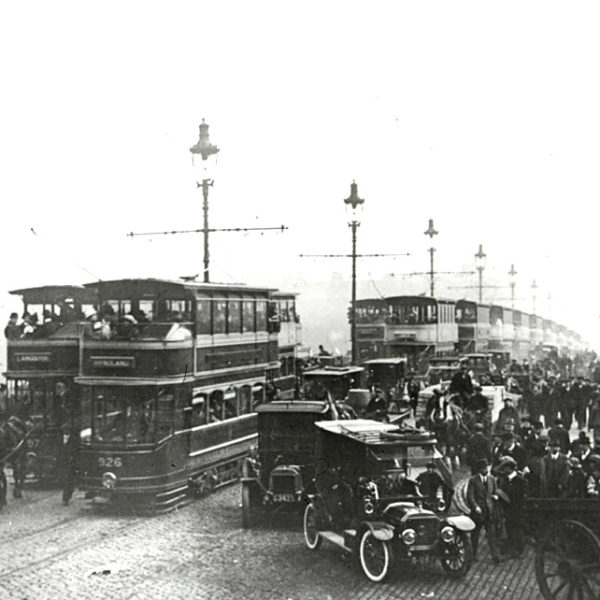In Search of John Maclean – part 1
Scotland has had few men whose names
Matter—or should matter—to intelligent people,
But of these MacLean, next to Burns, was the greatest.
—Hugh MacDiarmid, ‘Krassivy, Krassivy’ (1943)
I’m standing at the grave of John Maclean with my newfound cousin Roddy. We’re in the New Eastwood cemetery on the southern outskirts of Glasgow. It’s a clear, dry afternoon in August and the sunlight filters through the trees and dapples the green green grass underfoot. It’s quiet and very peaceful. A moment for reflection. Who was this man—and why have I come half way around the world to learn more about him?
The gravestone is about six feet tall mounted on a two-step plinth, with MACLEAN inscribed on the upper level. The stone itself reads simply:
IN LOVING MEMORY OF
JOHN MACLEAN, M.A.
DIED 30TH NOV 1923 AGED 44 YEARS.
Underneath, it goes on
HIS SISTER
MARGARET SMITH MACLEAN
DIED 17 AUG 1923
WIFE OF JOSEPH J. ARMSTRONG
John Maclean. A Scottish schoolteacher, socialist and revolutionary. A man who helped to plant the seeds of Marxism among the working classes of Scotland through his lectures, classes and speeches. Twice sentenced to hard labour in the notorious Peterhead Prison for speaking out against the First World War. Hailed as a socialist hero throughout Europe for his anti-war stance and appointed by Lenin as first Soviet Consul in Glasgow following the Russian Revolution.
A notable figure in British history you would think. But by and large, John Maclean has been airbrushed from that history.
Why is that? I ask myself.
Is it because ultimately he lost the battles he fought? The Marxist doctrine that capitalism would self-destruct and socialism would inevitably follow did not come to pass. Scotland did not become the co-operative commonwealth he dreamed of.
He was not one for compromises. When, a few years after the war, he was offered a teaching post on the condition he cease his political activities, he refused it. Instead, surviving on the meagre funds obtained from passing around the hat at speeches and meetings, he mounted campaign after campaign, in council elections and general elections.
In his final months he was surviving on pease brose, a porridge made with pea flour, in a state of semi-starvation. This, coupled with his insistence on giving outdoor speeches in Glasgow’s cold and foggy November nights, led to him contracting pneumonia.
In a truly tragic twist, he and his wife Agnes—who in despair at his insistence on putting his political work ahead of his family had taken their two young daughters and left him four years before—had decided to reconcile. She arrived from the border town of Hawick, where she had been keeping house for her unmarried sister, to find him too far gone to recover. She nursed him till he died. He was just 44. Unable to afford his own graveyard plot, he was buried with his recently deceased sister.
His sole monument on Clydeside is a small cairn in his birthplace of Pollokshaws. The fading inscription contains a fine sentiment—‘FAMOUS PIONEER OF WORKING-CLASS EDUCATION, HE FORGED THE SCOTTISH LINK IN THE GOLDEN CHAIN OF WORLD SOCIALISM.’ But the setting, outside a cheap supermarket and adjoined by a row of boarded up shops, speaks volumes about the man that Scotland forgot and his revolution that never was.
* * *
As with many things in my life it started with a song.
It was 1979. I was living in a share house in Adelaide. Donna had a record by Scottish folk singer Dick Gaughan. No More Forever it was called, a good record, but there was one song that stopped me in my tracks the first time I heard it. And the second. And every time since. ‘The John Maclean March.’
Hey, mac, did ye see him as he cam doun by Gorgie
Awa owre the Lammerlaw an north o the Tay?
Yon man is comin an the hail toun is turnin out
We’re aa shair he’ll win back tae Glesca the day
The jiners an hauders-on are merchin fae Clydebank
Come on nou an hear him he’ll be owre thrang tae bide
Turn out Jock an Jimmie, leave yer cranes an yer muckle gantries
Great John Maclean’s comin hame tae the Clyde
Now I am a proud Scot. From the working class. My dad was a steelworker. He moved the family from Scotland to work at Stewart and Lloyds in Corby, Northamptonshire and then across the seas to BHP in Whyalla, South Australia. His father worked in an aluminium smelter in the Highlands. Both staunch union men and Labour voters. I shared my dad’s taste for Scottish history—Glencoe, Culloden, Wembley 1967. My mother’s maiden name and my middle name are also Maclean. So, I asked myself, ‘How come I have never heard of this man?’
This was before the Internet, before Google, and so many years passed before I picked up the trail again. It was the eighties. I had moved to Sydney. Browsing in a second-hand bookshop in King Street, Newtown, I came across a biography of John Maclean. It was by his daughter Nan Milton. Cost me five bucks. And there it was—pretty much the whole story.
Milton told how a working class boy became a schoolteacher; found socialism; started teaching Marxism to factory and shipyard workers on the Clyde; preached the new gospel on the street and in halls all over Scotland; then when most other socialists abandoned their internationalist stance at the beginning of the Great War, became the most prominent anti-war activist in Scotland. How he was tried for sedition; imprisoned; became a socialist cult hero across Europe; and on his early release was appointed Soviet Consul in Scotland by Lenin. How he was arrested again for speaking out against the war; gave a defiant speech from the dock; saw prison again; went on hunger strike; and after the British War Cabinet—fearful of creating a martyr—granted him early release at the end of the war, how he returned to Glasgow to the hero’s welcome described in the song sung by Dick Gaughan. And after the war, the slow disintegration of his political career and his early death in 1923 at the age of 44.
My god, I thought again—how come I have never heard of this man? And the seed of a thought was planted. That this was still a dangerous man. And that his story had been excised from history.
Nan Milton’s book was comprehensive—long on detail but perhaps lacking in narrative. In the early nineties I was cruising the shelves at the Stanton Library in North Sydney on my lunch hour when I found a more exciting account of Maclean’s role in what is called ‘Red Clydeside’—Willie Gallacher’s Revolt On The Clyde.
My god, I thought again—how come I have never heard of this man? And the seed of a thought was planted. That this was still a dangerous man. And that his story had been excised from history.
Gallacher was a key figure in the period. Described by a contemporary as a man of action, who thought with his fists, he was one of the leaders of the Clyde Workers Committee, the organisation of shop stewards that in 1915 defied the official unions and resisted the government’s attempts to suspend workers’ rights, overhaul production methods and flood the munitions factories with cheap unskilled labour. He ran Maclean’s 1918 election campaign and was also prominent in the massive demonstrations in support of the forty-hour week in January 1919—demonstrations that the War Cabinet, fearing they were the start of a Bolshevik revolution on the Clyde, put down with troops, tanks and machine guns. And after travelling to Russia and meeting Lenin in 1920, he returned to Scotland as a cheerleader for the establishment of the Communist Party of Great Britain—a stance that saw him fall out irrevocably with Maclean.
Gallacher’s recounting of these events is racy, sometimes veering into ‘Boy’s Own’ territory. His descriptions of Maclean and his activities during the war are full of admiration and respect. But the tone changes in his account of the post-war years as he claims two terms of hard labour in Peterhead Prison had impaired Maclean’s mental state.
Nan Milton disputes this characterisation vigorously. While her book is infused with veneration of her father, she makes a plausible case that Gallagher’s denigration was a convenient lie to cover over the fact that in the cross-currents of post-war British socialism Maclean—still Britain’s most revered Socialist across Europe—was not toeing the Moscow line.
Revolt on the Clyde convinced me (not that I needed too much convincing) that this was a great story, a story that needed to be told. I vowed that when the opportunity came, I would try to do that.
One verse from the song haunted me.
Forward tae Glesca Green we’ll merch in guid order
Will grips his banner weill, that boy isnae blate!
Aye, weill, man, thair’s Johnnie nou, that’s him thair the bonnie fechter
Lenin’s his feir, laud, and Liebknecht’s his mate
Tak tent whan he’s speakin for thae’ll mind whit he said here
In Glesca, our city, an the hail warl besides …
‘Tak tent whan he’s speakin for thae’ll mind whit he said here.’ What DID he say there?
What did he say in any of his thousands of speeches? He was a renowned public speaker, capable of holding an audience in thrall for hours. How could I find his voice? Apart from a few set piece addresses, most notably his 75 minute address from the dock at his 1918 trial in Edinburgh’s High Court of Justiciary, he spoke off the cuff, without written notes. His words, so potent at the time, seemed ephemeral now.
* * *
Over the years I picked up more snippets. With the Internet growing and growing from the mid-nineties I would find treasures like the Red Clydeside section of the Glasgow Digital Library.
Just over two years ago I began what I like to think of as my ‘third act’, as a writer. The Maclean project was top of my list. I decided I would try to write a screenplay for a feature film based on his life.
I bought some books on scriptwriting and tried to work out how you could fit Maclean’s life into the classic Hollywood three-act structure. Hmmm, a tough assignment.
Still, I sketched out a plan. I’d start at the beginning of the Glasgow rent strikes around April 1915. This movement saw women in the working class areas of Govan and Partick, led by housewife Mary Barbour and suffragette Helen Crawfurd, band together to resist rent increases and prevent evictions.
I’d show how Maclean promoted support for this action amongst munitions workers by speaking outside factory and shipyard gates and encouraging the shop stewards in the Clyde Workers Committee to educate workers inside the works.
The rent strike movement culminated in a court case brought by landlords against tenants. Workers struck work and marched to the courthouse, picking up Maclean—who had been sacked from his teacher’s job the night before over a dispute with his headmaster—on the way. As Maclean whipped up the crowd outside, a deputation of workers advised the magistrate that convicting the tenants would see an all out strike by munitions workers on the Clyde. The magistrate persuaded the landlords to drop the case and the government introduced an Act restricting rent increases shortly afterwards.
And then to end the film, maybe I’d use the Battle of George Square in early 1919, thrillingly described by Gallacher in Revolt On The Clyde; where the massive demonstrations and strikes in support of the forty-hour week ended in a police riot against a forty thousand strong crowd in front of Glasgow City Chambers and deployment of raw Army recruits from England to keep order on the streets of Glasgow. The military authorities kept the Scottish regiments in their barracks, fearing they might join the demonstrators.
I had an opening scene in my mind. A view over Glasgow, smoke from factories and the sound of industry. A row of tenements, children playing hopscotch on the pavement. A bailiff coming along the street with eviction papers. Women in a communal laundry alerted to his presence. The women leaving their washing, ganging up on the bailiff and sending him on his way.
I had an opening scene in my mind. A view over Glasgow, smoke from factories and the sound of industry.
I needed a villain, a counterpoint and adversary to Maclean. I had a mental image of a bunch of Scottish fat cats sipping whisky in a boardroom set high above the Clyde as the workers toiled below. I found one in William Weir, the dynamic head of Weir’s of Cathcart, a successful engineering company that had developed the world’s leading marine pumps. Weir was a fan of American-style production line methods and butted heads with unions intent on maintaining existing privileges. Appointed by Lloyd George as Director of Munitions in Scotland during the war, he clashed with and eventually triumphed over the Clyde Workers Committee on the issue of flooding the factories with unskilled men and women to speed up munitions production.
But the more I thought about it, the harder I found it to envisage where all the action was taking place. I’d visited Glasgow a couple of times but I really wasn’t familiar with it at all. I decided the best thing was to go and have a look.
So I did.








Hi Donald! Michael MacGregor from Dundee here…came across yer post via Sandy Mathers on facebook. I ken the fella weel. We were both at different points members of the Revolutionary Communist Group here in Scotland. About 1998 I started writing one piece for our newspaper Fight Racism! Fight Imperialism!. Turned into an eight part series as I sifted the available material. We admire John MacLean, along with James Connolly, the two greatest revolutionaries these islands have produced. Here’s the links to my published material. Your views would be interesting…sorry to have missed you.
https://www.google.com/url?q=http://www.revolutionarycommunist.org/britain/general-election-2015/127-scotland/1972-john-maclean-part-i-battlepost-of-the-poor-frfi-146-dec-1998-1999&sa=U&ved=0ahUKEwip69bEhpnWAhWJnBoKHfW_CeI4ChAWCBYwBg&client=internal-uds-cse&usg=AFQjCNFdHsoO3vxxettY03cf0HjWn87ghg
Solidarity,
Michael MacGregor
Very interesting makes youthink about where you came from.
Thank you for the excellent and informative posts. I am sorry I have not read them before and happy I came across them this evening. I was researching as there is a movement afoot to build mid market rent properties next to the cairn, the work is commencing shortly. In my view the great man himself would be angry that there appears to be no provision for ‘social housing’ and/or council builds. Furthermore there are many of us who fear they may remove, damage, and misplace the cairn during their work. It has been inferred that the cairn will be moved closer to the road and the present parking slots removed. As a researcher I am sure you will find all the designs on line, should you choose to do so. All hands to the pump as it were to protect, the cairn and honour JM. God bless.
Thanks for letting me know and thanks for the kind comments Seumas. It would be a crying shame if the one acknowledgement of Maclean in his birthplace was removed.